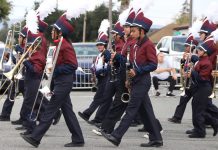
Hollister
– Ten-year-old Michael Sosa can’t imagine anything worse than
being a child during the 1850s.
Hollister – Ten-year-old Michael Sosa can’t imagine anything worse than being a child during the 1850s.
No television, no DVDs, no motorcycles and – worst of all – no Game Boy.
“You’ve pierced my heart!” the Sunnyslope fourth-grader said when he was told about the lack of modern entertainment 150 years ago.
After a year of learning about California history, fourth-graders at Sunnyslope School got to experience their lessons firsthand. On Friday, students learned what daily life – without Game Boys – was like for the pioneer men and women in California during the school’s annual Gold Rush Day.
“It adds context to what the children have been learning all year,” Sunnyslope Principal Melinda Scott said of the event. “Sometimes it’s hard for students to relate to a time past because it’s hard for them to imagine not having a cell phone or a TV remote.”
During Gold Rush Day, students learned about what children used for entertainment during the pioneer days in California.
The students made dolls using dried corn husks and bits of string. As Alejandra Anguiano, 9, tied bits of the corn husk together to make her doll’s arms, she experienced what it would be like to have to create her own toys.
“Because it’s the Gold Rush days, they didn’t have things that we have today, like TV,” Anguiano said.
Besides learning to make dolls, the students were given a lesson in pioneer life by Larry Brown, an expert on life during the Gold Rush era. Brown, dressed in a full pioneering costume, described to the students how different life would have been for them.
“Today, when you guys come home from school you flip on the lights, then you go to the fridge you get a snack, you stick it in the microwave,” Brown said. “But we’re going to go back in time to the 1850s.”
Brown proceeded to show the group of students the process of how they would heat up their food during the Gold Rush Era. Using a scrap of metal and flint, he showed the class how to make fire.
This was the most popular part of the lesson for most of the students, who watched with awe as the sparks caught on to the bits of dry grass.
The academic importance of this lesson was not lost on the fourth-graders. They had previously been taught about the lack of ovens on the pioneer trail, but seeing the effort that went into making the flame, they fully grasped what this actually meant.
“It would take a long time to make dinner,” Anguiano said.
While the day is important for the students learning, Scott also stressed that for most of them it’s just a chance to have a lot of fun while actually experiencing history.
“They get to see the actual items that they’ve been reading about and learning about,” Scott said. “They’re learning and it’s fun at the same time.”









